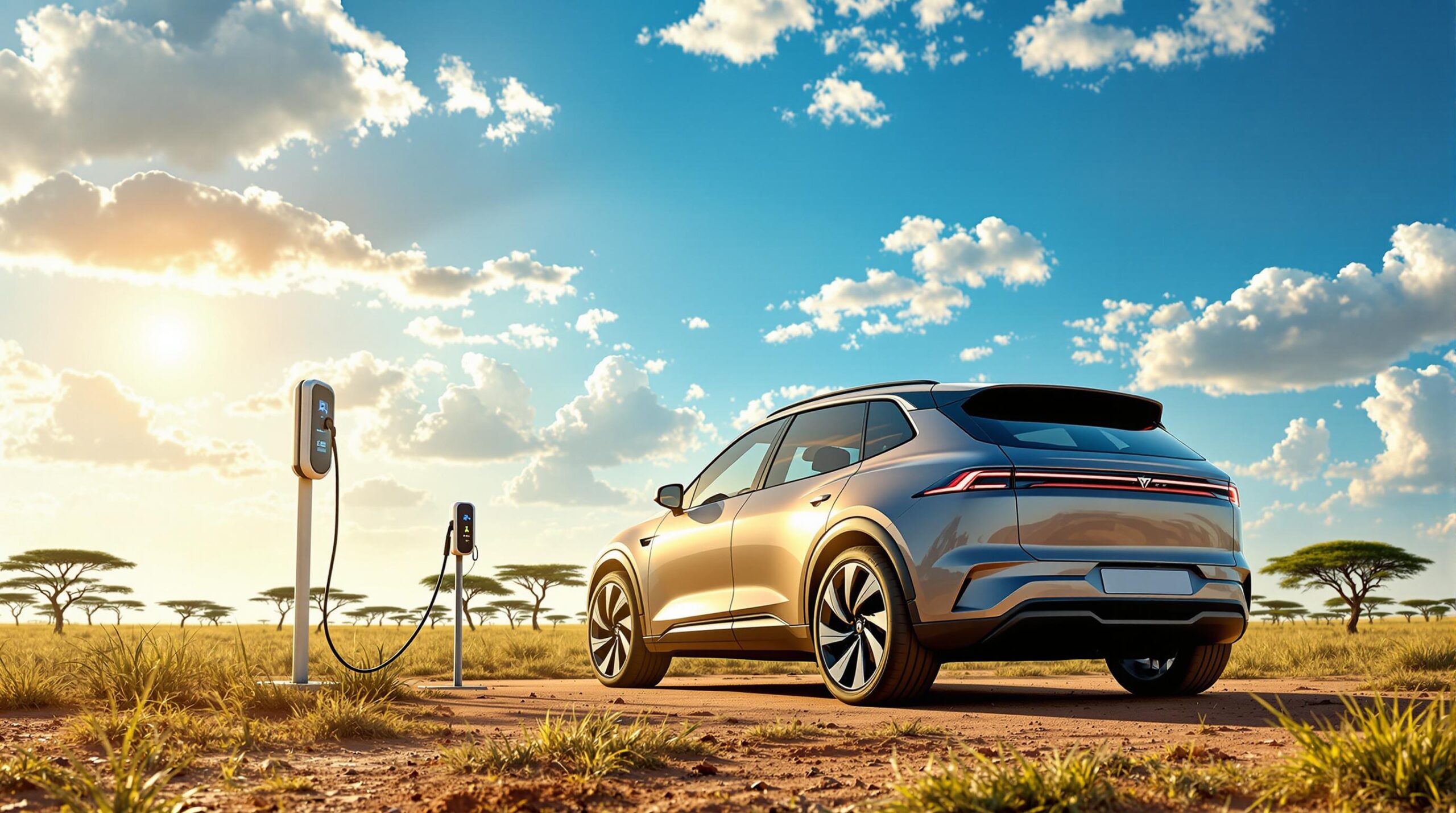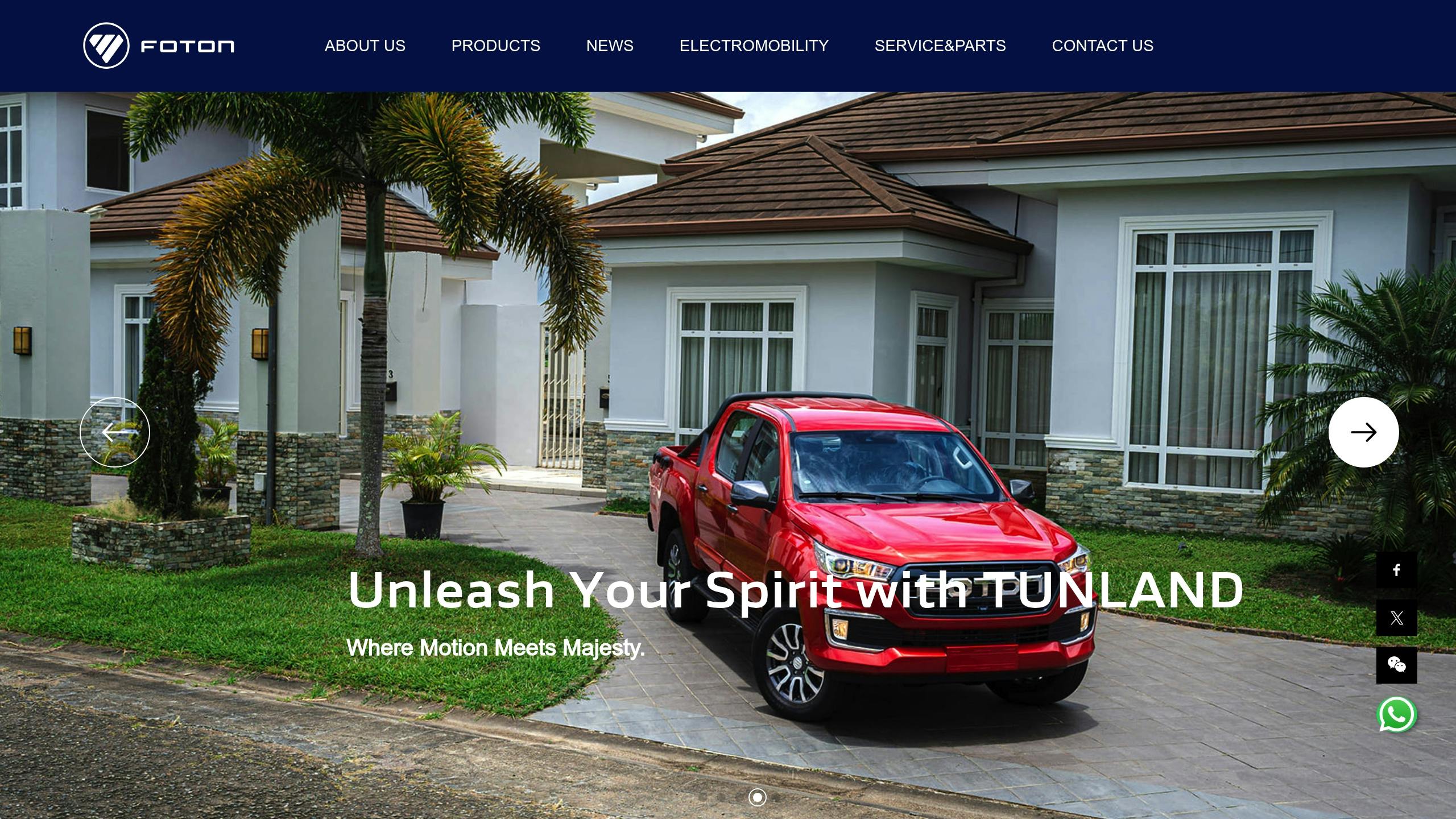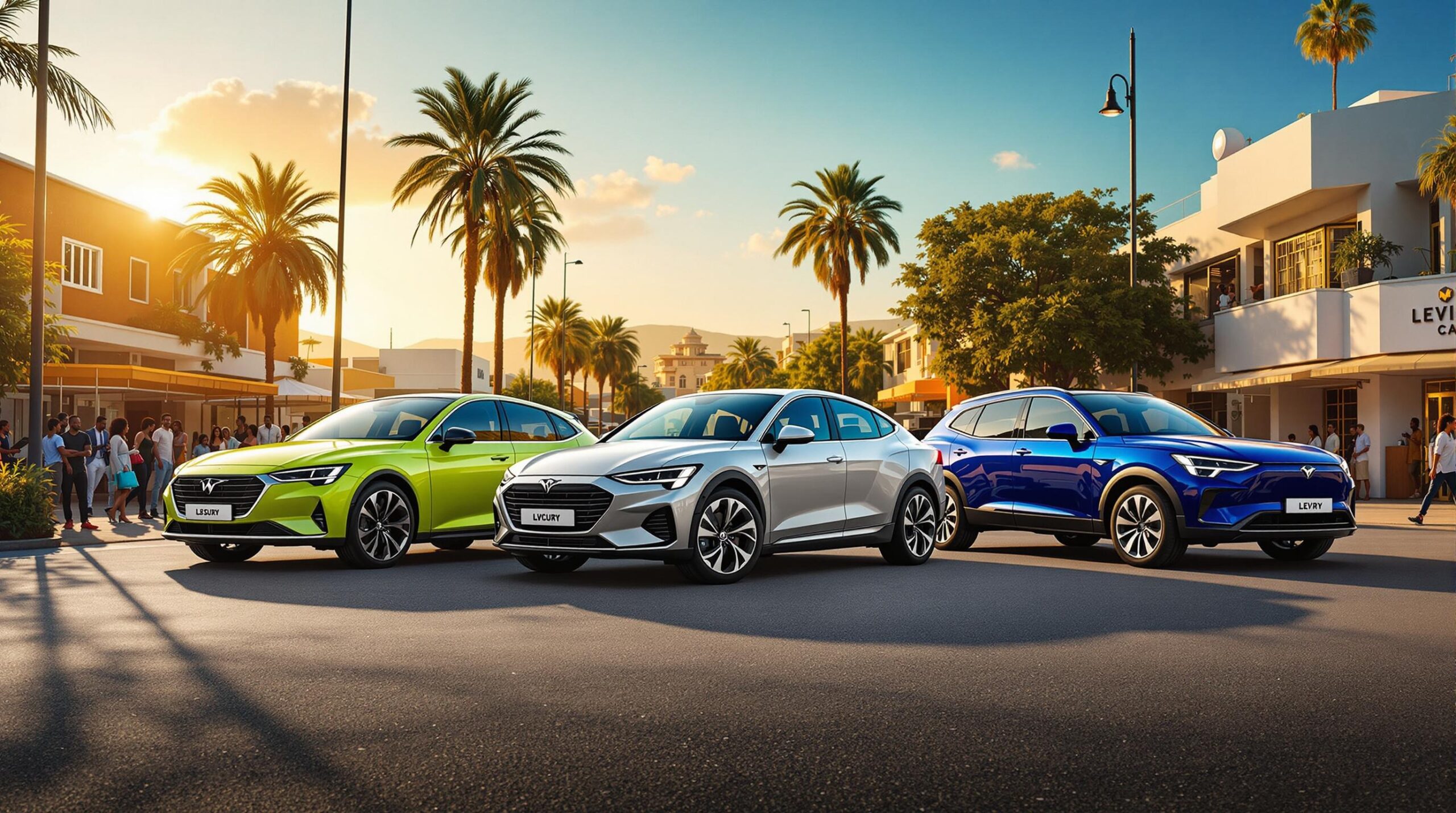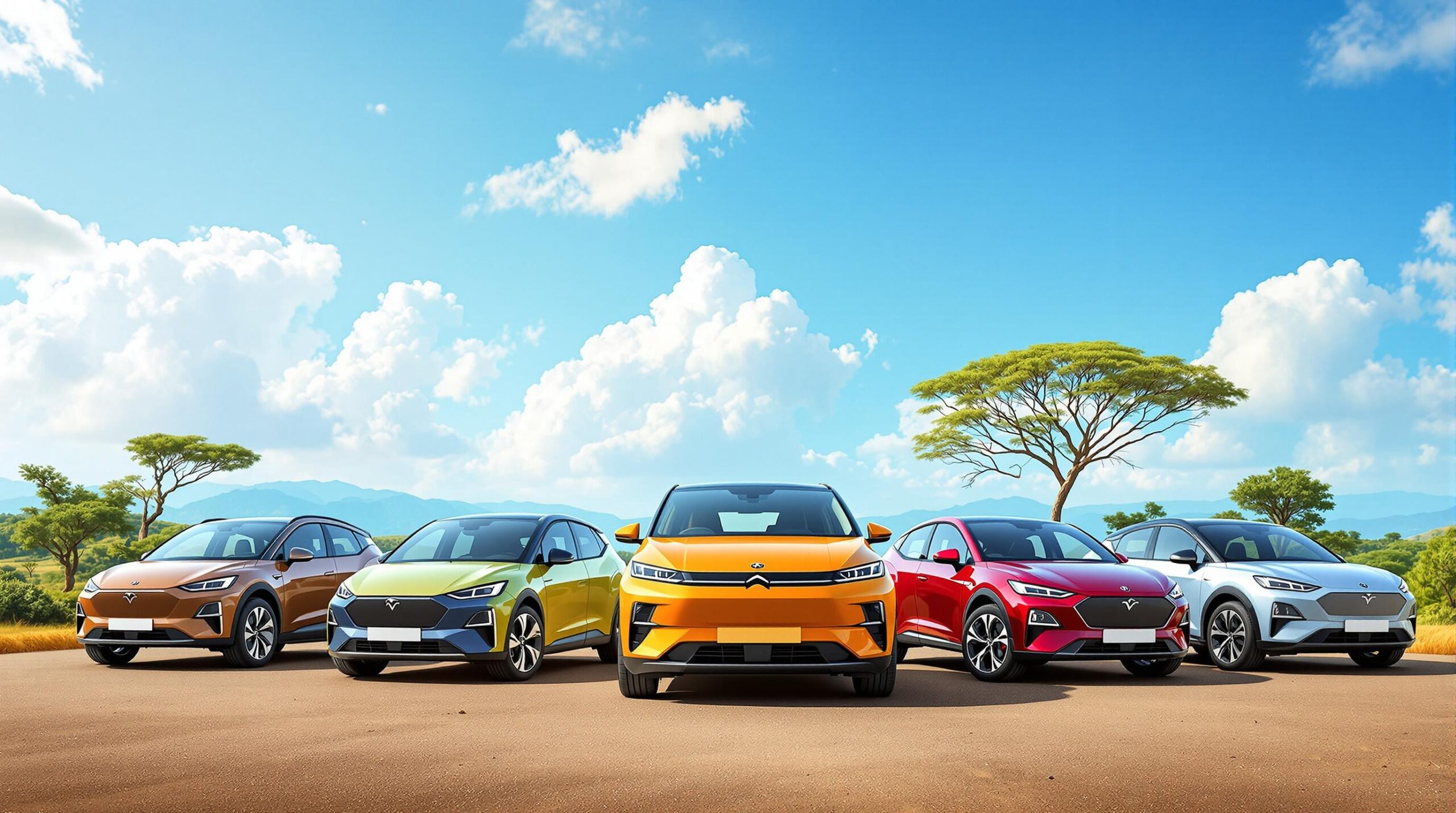
Africa’s electric SUV market is growing fast, driven by rising demand for eco-friendly vehicles and expanding charging infrastructure. Here are the top 8 electric SUVs making waves in the region:
- BYD Shark: Hybrid SUV with 800 km range, off-road capabilities, and a 230 mm ground clearance.
- Geely RD6 EV: Offers up to 517 km range, fast charging, and advanced features for urban and rural use.
- Changan Hunter: Extended-range electric SUV with 1,031 km total range and off-road versatility.
- Foton G9 EV: Up to 900 km range, rugged design, and safety-focused features.
- Maxus T90 EV 4WD: 330 km range, 1,000 kg payload, and tech-friendly interior.
- Isuzu Taga EV: Currently unavailable in African markets but rumored for future release.
- JMC DADAO EV: Two range options (370 km and 501 km), priced competitively for urban and off-road use.
- Dongfeng RICH 6 EV: 350 km range, quick charging, and durable design for commercial and personal use.
Quick Comparison
| Model | Range (km) | Charging Time (DC) | Payload (kg) | Key Feature | Price (Approx.) |
|---|---|---|---|---|---|
| BYD Shark | 800 | – | 2,500 | Off-road modes, 700 mm wading | – |
| Geely RD6 EV | 517 | 30-35 mins | 865 | Multiple battery options | – |
| Changan Hunter | 1,031 | ~30 mins | 495 | 3.3 kW power outlet | $19,450 – $30,150 |
| Foton G9 EV | 900 | – | – | Dual 12.3-inch displays | $18,000 (base) |
| Maxus T90 EV 4WD | 330 | 45 mins | 1,000 | Tech-friendly interior | R1.1 million |
| Isuzu Taga EV | – | – | – | Not yet available | – |
| JMC DADAO EV | 501 | – | – | Affordable urban and off-road use | $24,390 – $29,700 |
| Dongfeng RICH 6 EV | 350 | 3 hours | – | Durable and commercial-friendly | – |
Africa’s unique needs, such as rugged terrain and limited gasoline infrastructure, are shaping the design and features of these electric SUVs. With growing government support and infrastructure investments, electric SUVs are set to dominate the market in the coming years.
How BYD, Nio And Other Chinese EVs Compare To Tesla

1. BYD Shark
The BYD Shark is designed to tackle Africa’s varied landscapes with features that make it stand out in the hybrid pickup market.
This hybrid pickup is powered by a groundbreaking longitudinal Electric Hybrid System (EHS) drive assembly. It combines a 1.5L turbocharged engine with dual electric motors, delivering an impressive 321 kW (429 hp) of total power.
Key Performance Specs:
| Feature | Specification |
|---|---|
| Combined Range | 800 km |
| Pure Electric Range | 80-100 km |
| Fuel Consumption | 2.0L/100 km |
| Acceleration (0-100 km/h) | 5.7 seconds |
| Ground Clearance | 230 mm |
| Towing Capacity | 2,500 kg |
The Shark is built for tough terrain, offering 230 mm of ground clearance, approach and departure angles of 31° and 19.3° respectively, and a high-integrated off-road chassis with double-wishbone suspension for added stability.
Its 29.58 kWh LFP blade battery, featuring a Cell-to-Chassis design, increases structural rigidity by 22% and ensures durability. Additional features like Vehicle-to-Load (V2L) functionality allow you to power external devices, while dedicated driving modes for Gravel, Mud, and Sand make it versatile for off-road use.
At speeds under 70 km/h, the petrol engine works as a generator, while above that, it powers the front wheels, offering a combined 800 km range to minimize range concerns.
With a high-strength steel underbody plate, advanced driver assistance systems, and the ability to wade through water up to 700 mm deep, the BYD Shark is ready for demanding conditions.
2. Geely RD6 EV

Building on the success of the BYD Shark, the Geely RD6 EV brings a versatile battery system and a range of advanced features to the table.
Manufactured by Radar Auto, the RD6 EV is built on the SEA platform and designed to meet Africa’s varied transportation demands. It comes with three battery options:
| Battery Capacity | Range (CLTC) | Power Output | Acceleration (0–100 km/h) |
|---|---|---|---|
| 63 kWh | 373 km | 268 hp | 7.3 seconds |
| 73 kWh | 461 km (2WD) / 424 km (4WD) | 268–428 hp | 7.3–4.5 seconds |
| 86 kWh | 517 km (2WD) / 455 km (4WD) | 428 hp | 4.5 seconds |
These options make the RD6 EV suitable for everything from city driving to tougher rural routes, showcasing its adaptability to Africa’s diverse terrains.
Key performance highlights include a 225 mm ground clearance, 815 mm wading depth, an 865 kg payload, and a towing capacity of up to 2,500 kg.
Charging is efficient: DC fast charging takes the battery from 30% to 80% in just 30–35 minutes, while AC charging requires 7.9 to 11 hours, depending on the battery size.
Inside the cabin, you’ll find a 12.3-inch digital display, a touchscreen infotainment system, and a 9.0-inch head-up display. The load bay measures 1,525×1,450×540 mm, providing plenty of cargo space for various needs.
Geely introduced the RD6 EV in Thailand in November 2024, marking its first battery-powered pickup launch in a key production market.
With dimensions of 5,260×1,900×1,880 mm and a 3,120 mm wheelbase, the RD6 EV is slightly smaller than the Toyota Hilux. It also features side impact protection, responsive braking, and advanced driver assistance systems.
3. Changan Hunter

The Changan Hunter brings an extended-range electric powertrain to Africa’s electric pickup market. Equipped with a 31.18 kWh battery and a 2.0T range extender, it offers an impressive total range of 1,031 km and a pure electric range of 131–180 km. These features make it a practical option for everyday use.
| Powertrain Specs | Details |
|---|---|
| Electric Motors | 130 kW rear + 70 kW front (4WD) |
| Total Power Output | 200 kW (272 hp) |
| Maximum Torque | 470 N·m |
| Range Extender | 2.0T engine (140 kW) |
| Pure Electric Range | 131–180 km |
With dimensions of 5630 × 1930 × 1885 mm and a 3430 mm wheelbase, the Hunter is built for stable handling on diverse African roads. Its cargo box, measuring 1850 × 1595 × 500 mm, is ideal for commercial use, offering ample space for hauling goods.
One standout feature is the 3.3 kW power outlet in the truck bed, perfect for running tools or appliances in remote areas. Inside, the vehicle features a modern dual-screen setup, combining a 7.5-inch instrument cluster with a 12-inch infotainment display for a sleek and functional interior.
Pricing starts at 139,900 yuan (around $19,450 USD) for the Warrior Edition, with the premium Armor Edition priced at 216,900 yuan (about $30,150 USD).
The Hunter’s battery can charge to 80% in roughly 30 minutes, though charging infrastructure varies across African regions. Despite its 495 kg payload capacity, it doesn’t skimp on comfort, offering wireless charging, leather seats, and voice control. Its design strikes a balance between urban sophistication and rugged durability.
4. Foton G9 EV

The Foton G9 EV brings a mix of power and practicality suited for diverse African conditions. It runs on an AUCAN 2.0T engine paired with a ZF 8AT gearbox, delivering 120kW of power and 390N·m of torque. This setup ensures smooth performance across various terrains.
| Specification | Details |
|---|---|
| Engine Type | AUCAN 2.0T Electric |
| Maximum Power | 120kW |
| Maximum Torque | 390N·m |
| Body Width | 1960 mm |
| Wheel Size | 265/60R18 |
| Battery Range | Up to 900 km |
The G9 EV stands out with its 1960mm-wide body, inspired by American off-road design, which improves stability on African roads. Inside, it features dual 12.3-inch displays – one for the instrument cluster and another for central controls – offering an intuitive and modern interface.
Designed with African climates in mind, the G9 EV includes automatic temperature control and a 12-way adjustable driver’s seat with heating and ventilation options. These features aim to provide comfort no matter the weather.
The suspension system combines a front double-wishbone independent setup with a rear leaf spring non-independent configuration. This ensures a balance between off-road capability and load capacity, making it suitable for both urban and rural use.
For safety, the G9 EV is equipped with dual airbags, side airbags, side air curtains, pre-tightened seat belts, emergency autonomous braking, and driver drowsiness detection. These features enhance its appeal in the growing African EV market.
The G9 EV is competitively priced, with the base model starting at 129,800 yuan.
5. Maxus T90 EV 4WD

The Maxus T90 EV 4WD is an electric pickup designed for Africa, offering a solid mix of power and practicality. It comes equipped with an 88.55 kWh battery pack, delivering 150 kW (201 bhp) and 310 Nm of torque.
| Specification | Details |
|---|---|
| Battery Capacity | 88.55 kWh |
| Range (WLTP) | 330 km (205 miles) |
| Power Output | 150 kW (201 bhp) |
| Torque | 310 Nm |
| Payload Capacity | 1,000 kg |
| Ground Clearance | 187 mm |
Charging is straightforward: DC fast charging takes the battery from 20% to 80% in just 45 minutes, while a full charge using a 7kW AC charger requires 15 hours.
The T90 EV 4WD is built for both work and leisure, with a payload capacity of 1,000 kg and a towing limit of 750 kg. Its interior is fitted with a 10.25-inch touchscreen supporting Apple CarPlay and Android Auto, along with features like a reversing camera and rain-sensing wipers. These additions ensure a comfortable and tech-friendly driving experience.
Off-road capabilities are another highlight, with a 27° approach angle, 24° departure angle, and 187 mm ground clearance. These specs make it a reliable companion for rugged terrains.
Priced at R1.1 million in South Africa, the T90 EV 4WD balances premium features with practical value. It includes elements like a stainless steel sports bar, outside rope hooks, halogen headlights with automatic induction, and LED daytime running lights. These features make it well-suited for the varied demands of African roads and conditions.
sbb-itb-99e19e3
6. Isuzu Taga EV

Currently, there isn’t an electric version of the Isuzu Taga available in African markets. While there have been rumors about a potential electric model equipped with a lithium-ion battery and electric motor, these claims remain unconfirmed.
For now, buyers looking for electric vehicles should consider models that are already in production and widely available. This absence underlines the growing demand for reliable electric vehicle options in Africa.
7. JMC DADAO EV

The JMC DADAO EV is Jiangling Motors Corporation’s high-end electric pickup, introduced under its Dadao sub-brand. This sub-brand emphasizes versatility and premium features.
Powered by a 180 kW motor that generates 385 N·m of torque, the DADAO EV offers two range options: a standard 370 km and an extended 501 km version. It reaches a top speed of 140 km/h, making it a solid choice for both urban and off-road needs.
The vehicle comes with a practical 5-door, 5-seat layout, a 3270 mm wheelbase, and 265/65 R17 tires, ensuring both comfort and durability.
| Specification | Details |
|---|---|
| Motor Power | 180 kW |
| Torque | 385 N·m |
| Range | 370 km / 501 km |
| Maximum Speed | 140 km/h |
| Wheelbase | 3270 mm |
| Tire Size | 265/65 R17 |
For the African market, JMC has priced the 370 km version at $24,390 and the 501 km version at $29,700, making it a competitively priced option for buyers.
JMC’s production numbers further reflect its commitment to the EV market. In 2023, the company produced 307,425 vehicles, marking a 9.17% increase compared to the previous year. It also exported 1,203 thousand new energy vehicles, a jump of 77.6%.
With a strong focus on advancing technology – particularly in intelligent connectivity and energy solutions – and its collaboration with CATL for new energy development, the DADAO EV is positioned to make a strong impact in Africa’s growing automotive market.
8. Dongfeng RICH 6 EV
The Dongfeng RICH 6 EV brings a capable option to Africa’s growing electric pickup market. Built on the reliable Nissan F-Alpha platform, this 5-seater pickup combines practicality with modern electric technology. Its electric motor delivers 161 hp and 420 Nm of torque, making it a strong contender in its class.
The 60.16 kWh Lithium-Iron battery offers a driving range of 350 km. Charging is convenient, with a full charge taking 12 hours using AC or just 3 hours with DC fast charging. This makes it a solid choice for both city driving and regional trips.
| Specification | Details |
|---|---|
| Dimensions (L/W) | 5290 mm / 1820 mm |
| Wheelbase | 3150 mm |
| Motor Power | 161 hp |
| Torque | 420 Nm |
| Battery Capacity | 60.16 kWh |
| Range | 350 km |
| DC Charging Time | 3 hours |
Inside, the RICH 6 EV is equipped with a digital instrument panel and a 10.25-inch touchscreen for added convenience. Safety features include dual front airbags, traction control, vehicle dynamic control, and brake assist systems, ensuring a secure driving experience.
The suspension system features a double wishbone setup in the front and a leaf spring arrangement in the rear, making it capable of handling heavy loads and performing well across various terrains.
Dongfeng’s move into the African market comes at a time when the region’s electric vehicle industry is projected to grow significantly, reaching $21.4 billion by 2027 with a CAGR of 10.2% from 2022. This growth is fueled by increasing awareness of environmental issues and the availability of local battery resources.
For fleet operators looking to switch to electric vehicles, the RICH 6 EV offers a practical balance of performance, range, and utility. Its durable construction and well-rounded features make it an appealing option for commercial use in African markets.
SUV Specifications Comparison
When choosing an SUV, understanding its performance in relation to local driving conditions is crucial. The Geely RD6 EV stands out with a range of 460 km, powered by trihydride lithium batteries. Technical details for other models are expected soon, as manufacturers adjust features to meet the needs of African markets.
A recent analysis found that 72% of South African consumers are open to spending up to R600,000 on an electric vehicle. While EVs often come with higher upfront costs, they offer long-term savings through lower energy and maintenance expenses. Key perks include reduced cost per kilometer, fewer maintenance needs, longer vehicle lifespans, and zero direct emissions.
As charging infrastructure grows across Africa, electric SUVs are becoming more accessible. Projections suggest that by 2025, over 20% of new SUV sales will be electric or hybrid models.
These developments highlight the fast-paced transformation of Africa’s EV market.
Market Outlook
Africa’s electric SUV market is expanding quickly, fueled by decreasing battery prices, government incentives, and growing awareness of environmental concerns. Regional efforts highlight this shift.
In East Africa, Rwanda is taking the lead with tax breaks, lower electricity rates, and investments in charging infrastructure. Meanwhile, the Economic Community of West African States (ECOWAS) is driving change with stricter emissions rules and age limits on imported used vehicles.
Here are some key market projections:
| Metric | Projection |
|---|---|
| Market Value (2024) | US$15.8 billion |
| Market Value (2029) | US$25.4 billion |
| CAGR (2025-2029) | 22.1% |
| Expected EV Stock by 2040 (Base Case) | 13.5 million |
| Expected EV Stock by 2040 (Accelerated Case) | 25 million |
Currently, Africa’s electric SUV market makes up less than 1% of the global market, but falling costs are paving the way for growth. Urban areas are seeing improved charging networks, though rural regions still face connectivity hurdles. These developments are shaping how manufacturers approach the market.
To meet local demands, manufacturers are prioritizing longer driving ranges, improved durability, and the expansion of charging infrastructure. With continued government backing and infrastructure investments, electric SUVs are poised for notable growth across the continent.
FAQs
As the electric vehicle (EV) market evolves, here are some key FAQs about upcoming EV launches in South Africa.
What electric cars are coming to South Africa in 2025?
South Africa’s EV market is set to grow in 2025. Below is a list of confirmed models:
| Brand | Model | Expected Launch |
|---|---|---|
| Audi | Q6 e-tron | Q2 2025 |
| Audi | A6 Sportback e-tron | Q2 2025 |
| Audi | e-tron GT update | Q2 2025 |
| Leapmotor | C10 | September 2025 |
| Lexus | RZ | Early 2025 |
| MG | Cyberster | Early 2025 |
| Volvo | EX90 SUV | Q2/Q3 2025 |
South Africa’s charging network is also growing. There are approximately 400 public charging stations, thanks to efforts from companies like GridCars and Rubicon. These chargers are strategically placed at petrol stations, hotels, and shopping centers.
In 2024 alone, the number of charging sessions doubled, indicating greater consumer confidence in EVs. Government policies, combined with expanding infrastructure and incentives, are driving this shift, making the 2025 launches even more exciting for the market.




